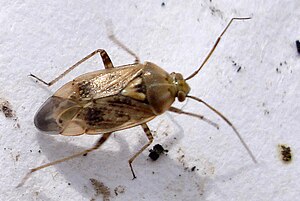Lygus rugulipennis
| Lygus rugulipennis | ||||||||||||
|---|---|---|---|---|---|---|---|---|---|---|---|---|

Lygus cf. rugulipennis |
||||||||||||
| Systematics | ||||||||||||
|
||||||||||||
| Scientific name | ||||||||||||
| Lygus rugulipennis | ||||||||||||
| Poppius , 1911 |
Lygus rugulipennis is a type of bug from the family of soft bugs (Miridae).
features
The bugs are 4.7 to 5.7 millimeters long. The species of the genus Lygus are very difficult to determine because they overlap in their coloration, pattern and size. The consequence of this is that some individuals cannot be clearly identified on the basis of external characteristics. The safest way to identify the animals is by looking at the fine features of the corium of the hemielytras , which can only be seen at great magnification. Lygus rugulipennis is one of the smaller species of the genus and has a densely fluffy corium. The distances between the hairs are usually much smaller than the length of the hairs.
Occurrence and habitat
The species is distributed Holarctic and occurs all over Europe, but is absent in North Africa. It is widespread in Central Europe and is one of the most common types of bedbugs. Nutrient-rich, open habitats are settled. The species avoids shady places, the degree of humidity does not seem to be so important for the choice of the populated habitat.
Way of life
The bugs are polyphagous and suck on very many herbaceous plants, especially from the families of the daisy family (Asteraceae), cruciferous (Brassicaceae) and legumes (Fabaceae). It has so far been demonstrated in 387 plant species from 57 families. Occasionally it can be harmful to potatoes, cabbage, beets, alfalfa, hops and also grain in agriculture. The animals, especially the nymphs , also prey on aphids and insect eggs.
The wintering takes place as an imago. After hibernating and laying eggs, most adults of the old generation disappear by June. Those of the new generation mainly appear from July and August and live until mid-September. The autumn generation imagines developed in mid-September, seeking to late November for suitable places for overwintering, mainly engaged in thick, dry litter as forest edges, hedges or in heaths with heather ( Calluna met). Occasionally, the bugs hibernate on conifers such as spruce ( Picea ), pine ( Pinus ), juniper ( Juniperus ) or arborvitae ( Thuja ). Two generations are trained per year in Central Europe. Further north, for example in Sweden or Scotland, there is only one. Like Lygus pratensis , the bugs look for suitable hibernation places on miles-long flights. After wintering, there are again long spreading flights in March and April, during which the bugs are particularly attracted by yellow flowers.
supporting documents
Individual evidence
- ↑ a b c d Ekkehard Wachmann , Albert Melber, Jürgen Deckert: Bugs. Volume 2: Cimicomorpha: Microphysidae (lichen bugs), Miridae (soft bugs) (= The animal world of Germany and the adjacent parts of the sea according to their characteristics and their way of life . 75th part). Goecke & Evers, Keltern 2006, ISBN 3-931374-57-2 , p. 88 f .
- ↑ Lygus rugulipennis. British Bugs, accessed January 4, 2015 .
literature
- Ekkehard Wachmann , Albert Melber, Jürgen Deckert: Bugs. Volume 2: Cimicomorpha: Microphysidae (lichen bugs), Miridae (soft bugs) (= The animal world of Germany and the adjacent parts of the sea according to their characteristics and their way of life . 75th part). Goecke & Evers, Keltern 2006, ISBN 3-931374-57-2 .
Web links
- Lygus rugulipennis at Fauna Europaea. Retrieved January 4, 2015